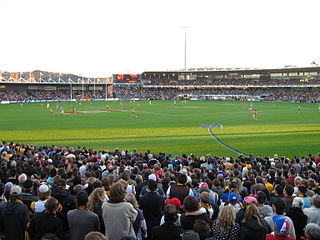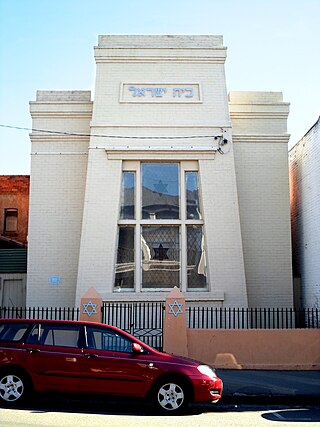
The Tasmanian was a newspaper published in Launceston, Tasmania, Australia between 1871 and 1895. [1]
Contents
Digitised editions from 1881 to 1895 are available via Trove. [1]

The Tasmanian was a newspaper published in Launceston, Tasmania, Australia between 1871 and 1895. [1]
Digitised editions from 1881 to 1895 are available via Trove. [1]

Launceston is a city in the north of Tasmania, Australia, at the confluence of the North Esk and South Esk rivers where they become the Tamar River (kanamaluka). As of 2021, the Launceston urban area has a population of 90,953. Launceston is the second most populous city in Tasmania after the state capital, Hobart. As of 2020, Launceston is the 18th largest city in Australia. Launceston is the fifth-largest inland city and the ninth-largest non-capital city in Australia. Launceston is regarded as the most livable regional city, and was one of the most popular regional cities to move to in Australia from 2020 to 2021. Launceston was named Australian Town of the Year in 2022.
Trial Harbour is a rural locality in the local government area (LGA) of West Coast in the North-west and west LGA region of Tasmania. The locality is about 20 kilometres (12 mi) south-west of the town of Zeehan. The 2016 census has a population of 24 for the state suburb of Trial Harbour.

The North Esk River is a major perennial river located in the northern region of Tasmania, Australia.

TheMercury is a daily newspaper, published in Hobart, Tasmania, Australia, by Davies Brothers Pty Ltd, a subsidiary of News Corp Australia, itself a subsidiary of News Corp. The weekend issues of the paper are called Mercury on Saturday and Sunday Tasmanian. The current editor of TheMercury is Craig Herbert.
The Arthur Highway (A9) is a Tasmanian highway which runs from Sorell in the near south to Port Arthur in the far south-east.

Norman Kirkwood Ewing was an Australian lawyer, politician and judge. He was born in New South Wales and moved to Western Australia in the 1890s. He served in the Western Australian Legislative Assembly from 1897 to 1901 and was elected to the Senate at the inaugural federal election in 1901. He resigned from the Senate in 1903 and moved to Tasmania in 1905, serving in the Tasmanian House of Assembly from 1909 to 1915. His last public role was as a judge on the Supreme Court of Tasmania from 1915 until his death in 1928.

Australian rules football in Tasmania, has been played since the late 1860s and draws the largest audience for a football code in the state.

Rail transport in Tasmania consists of a network of narrow gauge track of 1,067 mm reaching virtually all cities and major towns in the island state of Tasmania, Australia. Today, rail services are focused primarily on bulk freight, with no commercial passenger services being operated. The mainline railways of Tasmania are currently operated by TasRail, a Government of Tasmania-owned Corporation, who owns and maintains both rolling stock, locomotives, and track infrastructure.

The Stacks Bluff is a peak in northeast Tasmania, Australia. The mountain is situated on the Ben Lomond plateau.
The Zeehan and Dundas Herald was a newspaper for the West Coast Tasmania community, based in Zeehan and Dundas from 1890 to 1922.

The Launceston Synagogue is a heritage-listed building located in St. John's Street, Launceston, Tasmania, Australia, that served as a synagogue from 1846 until 1871, and again during the c. 1930s until its closure in 1961 and reopened in 1984.

Launceston College is a government comprehensive senior secondary school located in Launceston, Tasmania, Australia. Established in 1913 as the Launceston State High School and subsequently known as Launceston College, the college caters for approximately 1,200 students in Years 11 and 12, and an optional Year 13. The college is administered by the Tasmanian Department for Education, Children and Young People.
The Courier is a newspaper founded in 1827 in Hobart, Tasmania, as The Hobart Town Courier. It changed its name to The Hobart Town Courier and Van Diemen's Land Advertiser in 1839, settling on The Courier in 1840.
Hobart Walking Club is a recreational walking club based in Hobart, Tasmania, Australia that was started in 1929 by Jack Thwaites and Evelyn Temple Emmett
The Telegraph, later The Daily Telegraph was a newspaper published in Launceston, Tasmania between 1881 and 1928.

The Independent was a weekly English language newspaper published in Launceston, Tasmania from 1831 to 1835.
The Tasmanian Labor Party, officially known as the Australian Labor Party (Tasmanian Branch) and commonly referred to simply as Tasmanian Labor, is the Tasmanian branch of the Australian Labor Party. It has been one of the most successful state Labor parties in Australia in terms of electoral success.

Heinrich Wilhelm Ferdinand "Ferd" Kayser, was the mine manager of Mount Bischoff Tin Mining Company for thirty years.
The Tamar Hematite Iron Company (THIC) was an iron mining and smelting company that operated from April 1874 to December 1877, in the area close to the location of the modern-day township of Beaconsfield, Tasmania, Australia.
The Mount Lyell Standard was a Queenstown based newspaper in Western Tasmania, that was contemporaneous with the Zeehan and Dundas Herald. It was also known as the Mount Lyell Standard & Strahan gazette. The newspaper operated between 1896 and 1902.
![]() Media related to The Tasmanian at Wikimedia Commons
Media related to The Tasmanian at Wikimedia Commons